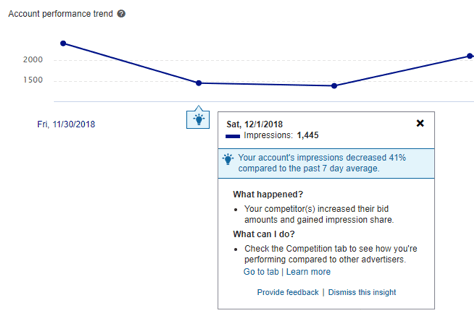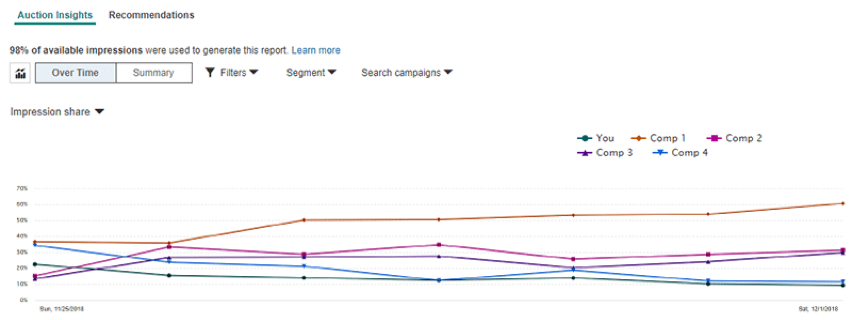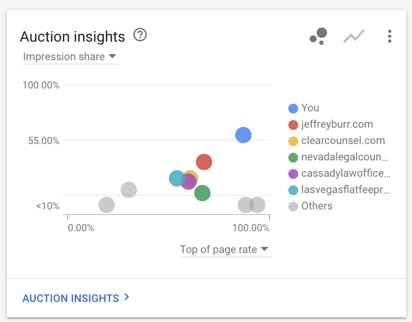New AI Bing Features that Google Doesn’t Have
Bing has released 3 new features that they are claiming to be unique to their platform. Recently partnered with Intent Lab near the end of 2018 – they are utilizing the power of AI and Machine Learning to deliver these smart insights to the users. The three features are Performance Insights, Location Targeting, and the Competition Tab. Each feature provides valuable insight for paid search advertisers in any industry.
Performance Insights
Performance Insights are a great new tool. Adwords has yet to create something similar in the trend line area of the platform. The closest comparison found may be in the Overview tab. This is a stretch comparison as the Overview tab will show “Biggest Changes” compared to the previous period, but has no AI to find a possible cause or reason.
In the Bing platform, there is now a lightbulb icon when there is a change in performance or trends. It offers an explanation of why this happened and other tips to raise performance.

You can see here, the change that has been flagged by Bing’s AI, a “What Happened” section, and a “What Can I Do?”. Not only are they flagging the change, but the reason behind the change, as well as options to diagnose and treat the issue.
This helps save time for advertisers. Now instead of seeing a change in trend lines, then having to dig into search queries and change histories to see what could have caused it – they can now see what likely happened through Bing Ads AI powered Performance Insight icon. This can be incredibly helpful and time-saving for quick PPC campaign checkups. For your law firm business, advertisers can quickly discover new PPC competitors on Bing with this tool.
Location Targeting
Right now, there is no clear place for advertisers to see suggested location targeting for their accounts in Google Ads. Bing now can use AI to find best performing advertisers similar to you or your client. Once analyzed, they display the recommended location with the estimated increase in impressions. They are still bound to locations within the area you do business, so the machine learning system will not recommend them.
In Google Ads, you can get impression estimates using the keyword planner, and targeting the specific location you would like estimates on. Bing takes this a step further by using Machine Learning to see what competitors are doing. You can quickly and easily add these new locations to targeting to start testing. This is a great time saver, and a helpful option to explore for underspending campaigns.
Competition Tab
In Bing Ads, there is an Auction Insights section (similar to Adwords). There are a couple helpful differences that Google doesn’t offer in their Auction Insights.

Bing shows the trend lines for each competitor, which offers helpful insight into changes throughout your selected time period. Google displays these insights as a snapshot of current auction players and their impression share (or your chosen metric). The recommendations tab in Bing is also a helpful feature. Although Google has a similar recommendations tab, Bing’s features an analysis on your ads vs. competitors and how your impression share compares over time.

These three features are extremely helpful to PPC advertisers. Although the information is mostly able to be found on Google, Bing makes it easy and intuitive to make changes based off these insights. This is a great example of Bing Ads trying to push past what Google offers, by creating features unique to their platform. Advertisers are still able to use both platforms easily – these changes haven’t created clashing platforms. The Google Campaign Import feature still is able to function as usual even with the new AI features Bing Ads has created.
Smart Search SERPs
One more item that differentiates Bing and Google is Bing’s new smart search SERP. You can see a huge difference in the example below. This mostly affects SEO as now more than one result can be featured in the Featured Snippet on Bing Search. This pushes paid results further down the SERP and may even lead to less clicks when answers are shown immediately at the top or side. Google has moved to a similar ‘smart search’ type SERP, although Bing is now introducing the multiple source featured snippets.

Sources:
Bing Ads Blog September 2018
Bing Ads Blog January 2019
Search Engine Land
Search Engine Land November 2018
Disclaimer: All content on this blog is provided for informational purposes only. The owner will not be liable for any errors in this information. The information is accurate to the owner’s knowledge but is subject to change.





